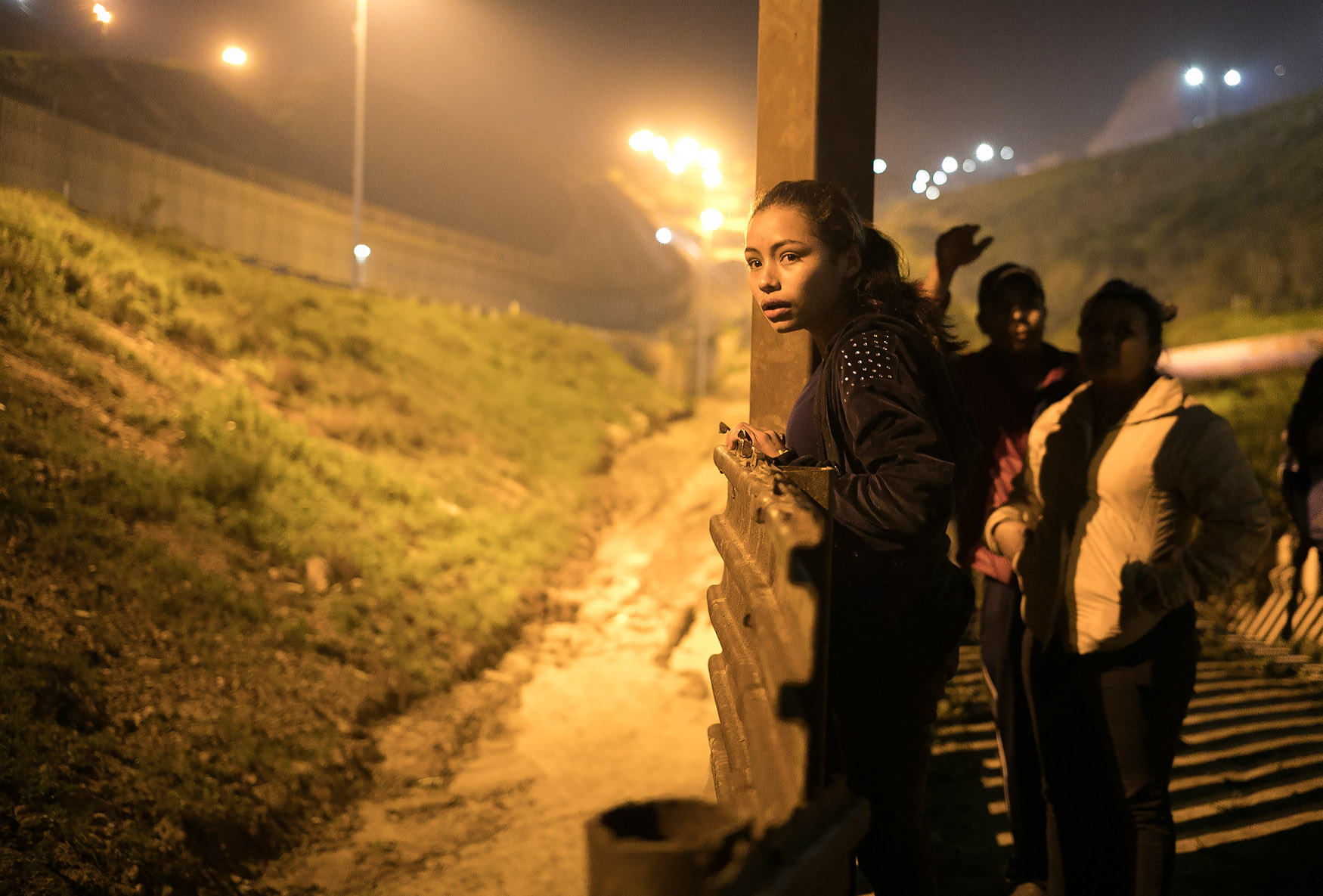Tijuana’s ‘Little Haiti’ stalled but migrants planting roots

Brightly colored clothes air from lines strung between rudimentary plywood-sided homes. Cinderblocks stacked chest-high form the skeletons of unfinished houses, and a pile of unused rebar lies in the dirt patio.
A billboard puts a name to what has become something of a neighborhood interrupted: “Little Haiti. City of God.”
A "Little Haiti City of God" sign stands at the entrance of a small neighborhood in Tijuana, Mexico, May 6, 2018. (AP Photo/Emilio Espejel)
The arid hillside barrio, on property belonging to the Ambassadors of Jesus evangelical church, made headlines last year when nearly 3,000 Haitians ended up in this city bordering San Diego on a failed bid to get to the United States. About 200 were taken in by the church.
But the church’s plans to build a community for Haitians hit a roadblock when civil defense officials said there was a flood risk and barred further construction. A year later, just eight of the 100 homes envisioned are in place, with another 50 people or so living in similar conditions in nearby Scorpion Canyon.
A resident of Little Haiti leaves a house built by a pastor and volunteers in Tijuana, Mexico, May 9, 2018. (AP Photo/Emilio Espejel)
“The neighborhood was not built, and the Haitians who were here went to rent elsewhere and became part of the work life,” Tijuana Mayor Juan Manuel Gastelum Buenrostro said.
Indeed, the denizens of Little Haiti represent a small portion of the local migrants from the impoverished Caribbean nation, many of whom are putting down roots just across the border from what was once their destination.
A woman holds her baby during a service at The First Baptist Church of Tijuana in Mexico, Feb. 26, 2018. The church is located in downtown Tijuana and forms an important part of Haitian community life in the city. (AP Photo/Emilio Espejel)
A man prays at the First Baptist Church of Tijuana, Mexico, May 5, 2018, (AP Photo/Emilio Espejel)
Most of the Haitians had gone to Brazil after a 2010 earthquake devastated their own country and found jobs during the Olympics and World Cup. When Brazil’s economy slumped and work dried up, they headed north. Some decided to stay in Tijuana because they had found decent work and were eager to settle down. Others said they feared the U.S. would be unwelcoming.
Across the city, Haitians have found employment as welders and factory workers, and have become part of the urban landscape, seen boarding buses, pumping gas or wading into traffic selling flavored waters to motorists.
Herllain Gamin, a Haitian migrant, counts his change at the gas station where he works in downtown Tijuana, Mexico, May 4, 2018. When he first arrived, Gamin said that he experienced racist attitudes from Mexicans, but now says he and others are accepted and welcomed by most. (AP Photo/Emilio Espejel)
Rosaline, a Haitian migrant, cuts spinach for a dish at her restaurant in downtown Tijuana, Mexico, May 4, 2018. (AP Photo/Emilio Espejel)
“With this job plus what my wife earns selling tamales ... it gives us enough to pay the rent and the monthly expenses,” said Thony Mersion, a 34-year-old working as a security guard at the Tijuana airport.
On Sundays, many attend a special service at Ambassadors of Jesus. Recently the Haitian ambassador flew up from Mexico City to officiate at a mass wedding of his compatriots. Some have now had Mexican-born children, which makes it easier to qualify for residency.
A bride exchanges vows during a mass wedding held at the First Baptist Church of Tijuana, Mexico, May 5, 2018. Eighteen couples, all of them Haitian migrants, were married at the ceremony. (AP Photo/ Emilio Espejel)
Brides and their guests sit on a bench in a parking lot prior to a mass wedding at the First Baptist Church of Tijuana, Mexico, May 5, 2018. (AP Photo/Emilio Espejel)
Tony, a groom-to-be, talks on the phone before his marriage ceremony at the First Baptist Church of Tijuana, Mexico, May 5, 2018. (AP Photo/Emilio Espejel)
A bride-to-be looks at the camera before her wedding at the First Baptist Church of Tijuana, Mexico, May 5, 2018. (AP Photo/Emilio Espejel)
Maid-of-honor Evita, 43, poses before her friend's wedding at the First Baptist Church of Tijuana, Mexico. She attended the wedding with her child, who was born in the country. (AP Photo/Emilio Espejel)
Groom-to-be Jeremy Rebien, 31, poses for a portrait with his daughter, who was born in Mexico. before his wedding at the First Baptist Church of Tijuana, Mexico. (AP Photo/Emilio Espejel)
A newly-wedded bride and her friends head to an after-party in Tijuana, Mexico, May 5, 2018. (AP Photo/Emilio Espejel)
One of the most successful, commercially, is Marie Toussaint, 30, who this year opened a beauty salon with money loaned from an uncle in Los Angeles.
“With how well it’s going, I can hire Mexican employees to attend to my clients who come from San Diego,” Toussaint said.
Marie Toussaint gives a pedicure to a customer at her local beauty salon in downtown Tijuana, Mexico, May 5, 2018. (AP Photo/Emilio Espejel)
The Haitians also got a high-profile shout-out last week when, during a presidential debate, candidate Ricardo Anaya praised Tijuana for taking them in.
“I get goose bumps. ... That is the Mexico I want, a generous Mexico, a Mexico with arms open,” Anaya said.
However, an estimated 500 to 800 arrived after authorities stopped issuing humanitarian visas for Haitians in April 2017, and they are living on society’s fringes, unable to work legally.
Pierre Franzzy, 26, said he goes almost every week to the migration office, trying to legalize his status. But when a high-profile caravan of Central American migrants that had attracted the ire of U.S. President Donald Trump arrived in the city recently, he was told his case was no longer a priority.
“For that reason I have made the decision to return to Haiti voluntarily before they file a complaint or deport me,” Franzzy said.
Pierre Franzzi shows off a red cap with his country's flag emblazoned on it outside the Ambassadors of Jesus Church in Tijuana, Mexico, May 4, 2018. (AP Photo/Emilio Espejel)
Back in Little Haiti, pastor Gustavo Banda said about $20,000 has been spent on the existing homes and he’s hopeful — optimistic, even — that he’ll be able to put up more, despite the opposition from civil defense officials.
“Here the property tax is paid and the government does not do anything for the improvement of the homes ... or even basic services such as trash collection, paving and drainage,” Banda said. “We have been dealing with this problem for 12 years, and this will not stop us.”
“The Haitians wish to stay here, and with the government authorizing them in two years to bring close relatives who currently live in Haiti, I am sure that Little Haiti is going to become a community with Creole as its main language,” he added.
A man cuts his friend's hair in Tijuana, Mexico, February 25, 2018. Now closed, the space was used as a barbershop on the weekends and a cultural center and meeting point for Haitian migrants during the week. (AP Photo/Emilio Espejel)
A man eats chicken with rice at Yolanda's Haitian restaurant in Tijuana, Mexico, Feb. 20, 2018. Yolanda runs the restaurant with her husband and a partner. (AP Photo/Emilio Espejel)
A man stands in the doorway of a cultural center and barbershop in Tijuana, Mexico, February 25, 2018. (AP Photo/Emilio Espejel)
Adriana, from Mexico, and Etienne, from Haiti, take a selfie during a party in Tijuana, Mexico, Feb. 25, 2018. (AP Photo/Emilio Espejel)
Not all envision a permanent stay in the neighborhood, which is next to a pungent wastewater channel at the bottom of Scorpion Canyon.
Saintanier Jeune, 40, has a stable factory job and said he is comfortable in Little Haiti. But he hasn’t lost sight of the U.S., visible from a nearby high point in the form of San Diego’s bay and gleaming office towers.
Lights shine over the city of Tijuana, Mexico, Feb. 21, 2018. San Diego's office towers can be seen in the distance. (AP Photo/Emilio Espejel)
“I have the possibility to become a permanent Mexican resident since my daughter was born in this country,” Jeune said. “Still, I want to leave ... because I do think I could have a better quality of life on the other side.”
The sun sets over the U.S.-Mexico barrier that runs into the Pacific Ocean in Tijuana, Mexico, Feb. 28, 2018. According to authorities, there are an estimated 500 to 800 Haitian migrants in Tijuana who arrived after the U.S. stopped issuing humanitarian visas for people from Haiti in April 2017. They are now living on society's fringes, unable to work legally. (AP Photo/Emilio Espejel)
Text from story AP story, Tijuana’s ‘Little Haiti’ stalled but migrants planting roots by Nancy Moya.
Photos by Emilio Espejel


























